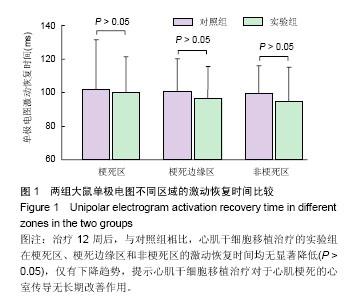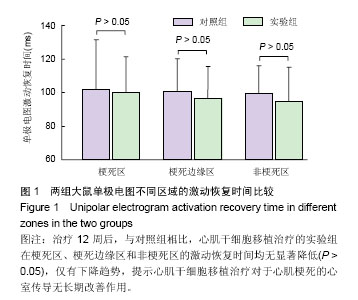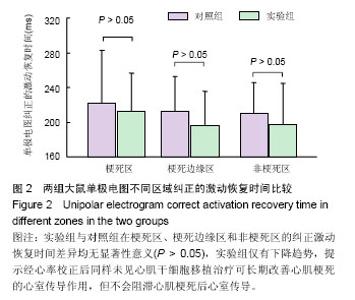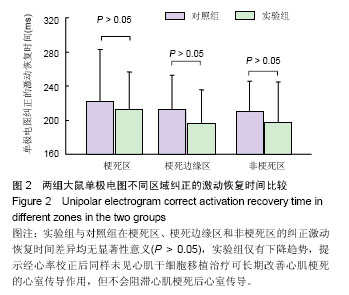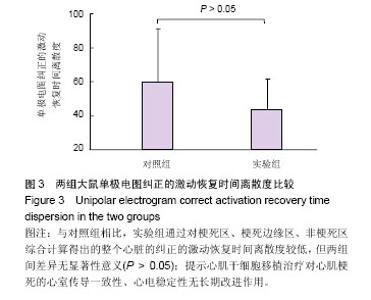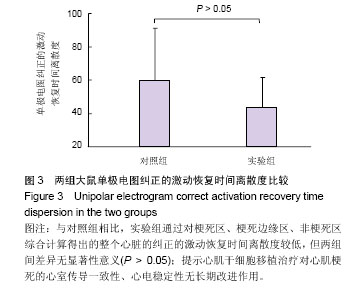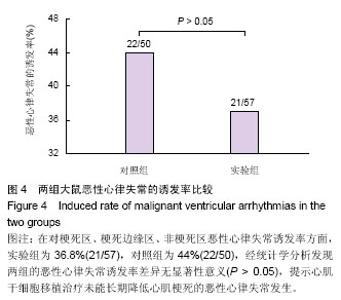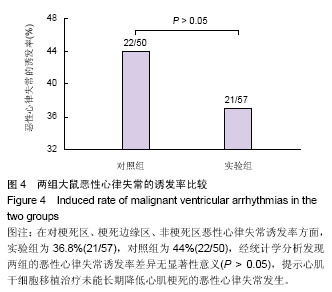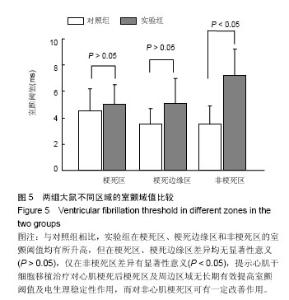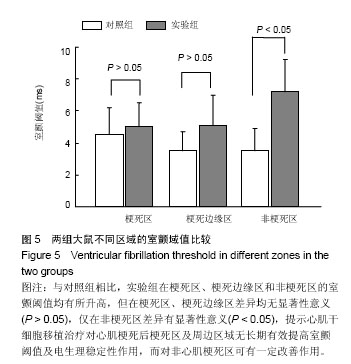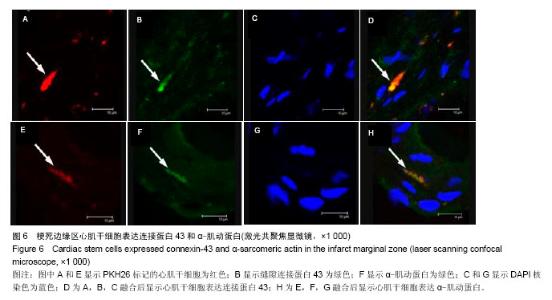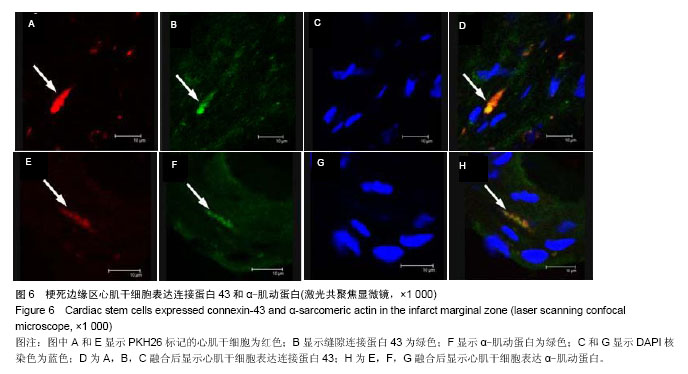Chinese Journal of Tissue Engineering Research ›› 2015, Vol. 19 ›› Issue (10): 1516-1522.doi: 10.3969/j.issn.2095-4344.2015.10.008
Previous Articles Next Articles
Long-term effects of cardiac stem cells transplantation to improve the electrophysiological stability and ventricular fibrillation threshold after myocardial infarction
Chen Li-peng1, Yan Ping2, Guo Tian-zhu3, Hou Jing-ying3, Zheng Shao-xin3, Zhou Chang-qing3,Long Hui-bao3, Zhong Ting-ting3, Wang Tong3
- 1Western Area Hospital, Zhongshan 528400, Guangdong Province, China; 2Department of Emergency, the First Affiliated Hospital of Guangzhou Medical University, Guangzhou 510120, Guangdong Province, China; 3Department of Emergency, Sun Yat-sen Memorial Hospital, Sun Yat-sen University, Guangzhou 510120, Guangdong Province, China
-
Online:2015-03-05Published:2015-03-05 -
Contact:Wang Tong, M.D., Doctoral supervisor, Professor, Chief physician, Researcher, Department of Emergency, Sun Yat-sen Memorial Hospital, Sun Yat-sen University, Guangzhou 510120, Guangdong Province, China -
About author:Chen Li-peng, Associate chief physician, Western Area Hospital, Zhongshan 528400, Guangdong Province, China -
Supported by:the National Natural Science Foundation of China, No. 81070125, 81270213; the Scientific and Technological Plan of Guangdong Province, No. 2010B031600032; the Fundamental Research Funds for Universities-Key Cultivation Project of Young Teachers in Sun Yat-sen University, No. 13ykzd16
CLC Number:
Cite this article
Chen Li-peng, Yan Ping, Guo Tian-zhu, Hou Jing-ying, Zheng Shao-xin, Zhou Chang-qing,Long Hui-bao, Zhong Ting-ting, Wang Tong. Long-term effects of cardiac stem cells transplantation to improve the electrophysiological stability and ventricular fibrillation threshold after myocardial infarction[J]. Chinese Journal of Tissue Engineering Research, 2015, 19(10): 1516-1522.
share this article
| [1]Labarthe DR, Dunbar SB. Global cardiovascular health promotion and disease prevention: 2011 and beyond. Circulation. 2012;125(21):2667-2676.
[2]Bolli R, Chugh AR, D'Amario D, et al. Cardiac stem cells in patients with ischaemic cardiomyopathy (SCIPIO): initial results of a randomised phase 1 trial. Lancet. 2011;378 (9806):1847-1857.
[3]Donndorf P, Strauer BE, Haverich A, et al. Stem cell therapy for the treatment of acute myocardial infarction and chronic ischemic heart disease.Curr Pharm Biotechnol. 2013;14(1): 12-19.
[4]Pavo N, Charwat S, Nyolczas N, et al. Cell therapy for human ischemic heart diseases: critical review and summary of the clinical experiences. J Mol Cell Cardiol. 2014;75:12-24.
[5]Taylor J. Boosting acute myocardial infarction treatment with stem cells. Eur Heart J. 2014;35(16):1015-1016.
[6]Menasché P. Stem cell therapy for heart failure: are arrhythmias a real safety concern. Circulation. 2009;119(20): 2735-2740.
[7]Lalit PA, Hei DJ, Raval AN, et al. Induced pluripotent stem cells for post-myocardial infarction repair: remarkable opportunities and challenges. Circ Res. 2014;114(8):1328- 1345.
[8]Marbán E, Cho HC, Cingolani E. Taking the cells out of cell therapy. J Am Coll Cardiol. 2012;60(17):1707-1708.
[9]Narita T, Shintani Y, Ikebe C, et al. The use of cell-sheet technique eliminates arrhythmogenicity of skeletal myoblast-based therapy to the heart with enhanced therapeutic effects. Int J Cardiol. 2013;168(1):261-269.
[10]Li GR, Deng XL, Sun H, et al. Ion channels in mesenchymal stem cells from rat bone marrow. Stem Cells. 2006; 24(6): 1519-1528.
[11]Askar SF, Ramkisoensing AA, Atsma DE, et al. Engraftment patterns of human adult mesenchymal stem cells expose electrotonic and paracrine proarrhythmic mechanisms in myocardial cell cultures. Circ Arrhythm Electrophysiol. 2013; 6(2):380-391.
[12]Hare JM, Fishman JE, Gerstenblith G, et al. Comparison of allogeneic vs autologous bone marrow–derived mesenchymal stem cells delivered by transendocardial injection in patients with ischemic cardiomyopathy: the POSEIDON randomized trial. JAMA. 2012;308(22):2369-2379.
[13]Liao SY, Liu Y, Siu CW, et al. Proarrhythmic risk of embryonic stem cell-derived cardiomyocyte transplantation in infarcted myocardium. Heart Rhythm. 2010;7(12):1852-1859.
[14]Chong JJ, Yang X, Don CW, et al. Human embryonic-stem- cell-derived cardiomyocytes regenerate non-human primate hearts. Nature. 2014;510(7504):273-277.
[15]van den Heuvel NH, van Veen TA, Lim B, et al. Lessons from the heart: mirroring electrophysiological characteristics during cardiac development to in vitro differentiation of stem cell derived cardiomyocytes. J Mol Cell Cardiol. 2014;67:12-25.
[16]Keung W, Boheler KR, Li RA. Developmental cues for the maturation of metabolic, electrophysiological and calcium handling properties of human pluripotent stem cell-derived cardiomyocytes. Stem Cell Res Ther. 2014;5(1):17.
[17]Ye J, Yeghiazarians Y. Cardiac stem cell therapy: review of the native cardiac progenitor cells and future direction. J Cardiovasc Pharmacol. 2014;63(2):85-94.
[18]Hou J, Wang L, Jiang J, et al. Cardiac stem cells and their roles in myocardial infarction. Stem Cell Rev. 2013;9(3): 326-338.
[19]Wang T, Tang W, Sun S, et al. Improved outcomes of cardiopulmonary resuscitation in rats with myocardial infarction treated with allogenic bone marrow mesenchymal stem cells. Crit Care Med. 2009;37(3):833-839.
[20]Wang T, Sun S, Wan Z, et al. Effects of bone marrow mesenchymal stem cells in a rat model of myocardial infarction. Resuscitation. 2012;83(11):1391-1396.
[21]王彤,郑韶欣,周长青,等.心肌干细胞移植可改进心力衰竭大鼠室颤阈值和电生理的稳定性[J].中国组织工程研究和临床康复, 2011,15(36): 6753-6756.
[22]Zheng S, Zhou C, Weng Y, et al. Improvements of cardiac electrophysiologic stability and ventricular fibrillation threshold in rats with myocardial infarction treated with cardiac stem cells. Crit Care Med. 2011;39(5):1082-1088.
[23]Xia Y, Kongstad O, Hertervig E, et al. Activation recovery time measurements in evaluation of global sequence and dispersion of ventricular repolarization. J Electrocardiol. 2005; 38(1):28-35.
[24]Western D, Hanson B, Taggart P. Measurement bias in activation-recovery intervals from unipolar electrograms. Am J Physiol Heart Circ Physiol. 2015;308(4):H331-H338.
[25]Wang H, Tang W, Ristagno G, et al. The potential mechanisms of reduced incidence of ventricular fibrillation as the presenting rhythm in sudden cardiac arrest. Crit Care Med. 2009;37(1):26-31.
[26]Hsiao LC, Carr C, Chang KC, et al. Stem cell-based therapy for ischemic heart disease. Cell Transplant. 2013;22(4): 663-675.
[27]Poon E, Kong CW, Li RA. Human pluripotent stem cell-based approaches for myocardial repair: from the electrophysiological perspective. Mol Pharm. 2011;8(5): 1495-1504.
[28]Garbern JC, Lee RT. Cardiac stem cell therapy and the promise of heart regeneration. Cell Stem Cell. 2013; 12(6):689-698.
[29]Simpson DL, Mishra R, Sharma S, et al. A strong regenerative ability of cardiac stem cells derived from neonatal hearts. Circulation. 2012;126(11 Suppl 1):S46-53.
[30]Ellison GM, Vicinanza C, Smith AJ, et al. Adult c-kit(pos) cardiac stem cells are necessary and sufficient for functional cardiac regeneration and repair. Cell. 2013;154(4):827-842.
[31]El Haddad M, Houben R, Stroobandt R, et al. Novel algorithmic methods in mapping of atrial and ventricular tachycardia. Circ Arrhythm Electrophysiol. 2014;7(3):463-472.
[32]Trevisi N, Silberbauer J, Radinovic A, et al. New diagnostic criteria for identifying left-sided ventricular ectopy using non-contact mapping and virtual unipolar electrogram analysis. Europace. 2015;17(1):108-116.
[33]Chugh AR, Beache GM, Loughran JH, et al. Administration of cardiac stem cells in patients with ischemic cardiomyopathy: the SCIPIO trial: surgical aspects and interim analysis of myocardial function and viability by magnetic resonance. Circulation. 2012;126(11 Suppl 1):S54-64.
[34]Fontes MS, van Veen TA, de Bakker JM, et al. Functional consequences of abnormal Cx43 expression in the heart. Biochim Biophys Acta. 2012;1818(8):2020-2029.
[35]Wu W, Li Y, Lu Z, et al. Increased susceptibility to ischemia-induced ventricular tachyarrhythmias in depressed rats: Involvement of reduction of connexin 43. Exp Ther Med. 2012;3(2):192-194.
[36]Oh H, Bradfute SB, Gallardo TD, et al. Cardiac progenitor cells from adult myocardium: homing, differentiation, and fusion after infarction. Proc Natl Acad Sci U S A. 2003;100(21): 12313-12318.
[37]Bolli R, Tang XL, Sanganalmath SK, et al. Intracoronary delivery of autologous cardiac stem cells improves cardiac function in a porcine model of chronic ischemic cardiomyopathy. Circulation. 2013;128(2):122-131.
[38]Amsalem Y, Mardor Y, Feinberg MS, et al. Iron-oxide labeling and outcome of transplanted mesenchymal stem cells in the infarcted myocardium. Circulation. 2007;116(11 Suppl): I38-45.
[39]Hong KU, Guo Y, Li QH, et al. c-kit+ Cardiac stem cells alleviate post-myocardial infarction left ventricular dysfunction despite poor engraftment and negligible retention in the recipient heart. PLoS One. 2014;9(5):e96725.
[40]Gullo C, de Almeida Zia VA, Vilela-Martin JF. Blockade of renin angiotensin system in heart failure post-myocardial infarction: what is the best therapy. Recent Pat Cardiovasc Drug Discov. 2014;9(1):28-37.
[41]von Lueder TG, Wang BH, Kompa AR, et al. Angiotensin receptor neprilysin inhibitor LCZ696 attenuates cardiac remodeling and dysfunction after myocardial infarction by reducing cardiac fibrosis and hypertrophy. Circ Heart Fail. 2015;8(1):71-78. |
| [1] | Zhang Chaohui, Zhao Feng, Feng Yunpeng, Wang Wenbin, Kuang Baoping, Huang He. Research progress and medical application of modeling and simulation of cardiovascular system [J]. Chinese Journal of Tissue Engineering Research, 2019, 23(7): 1115-1121. |
| [2] | Zhao Guangqiang. Tanreqing injection combined with ambroxol hydrochloride in treating heart failure and pulmonary infection caused by senile degenerative heart disease: a parallel, randomized, controlled clinical trial [J]. Chinese Journal of Tissue Engineering Research, 2019, 23(27): 4402-4407. |
| [3] | Wu Jiangbo1, 2, Xie Anqing3, Zhang Yong2. Mechanism of aerobic exercise improving chronic heart failure by irisin [J]. Chinese Journal of Tissue Engineering Research, 2019, 23(11): 1781-1787. |
| [4] | Lu Meng-xiao, Zheng Yuan-yuan, Liu Yang, Lu Jian-wei, Li Peng, Wu Ming-yuan. Clinical treatment of heart failure by adult stem cells: existing problems and prospects [J]. Chinese Journal of Tissue Engineering Research, 2018, 22(9): 1463-1469. |
| [5] | Wu Ni-na, He Jian-yun, Zhu Lei, Li Xiao-mei. The safety and efficacy of bone marrow stem cell transplantation for ischemic heart failure: a Meta-analysis [J]. Chinese Journal of Tissue Engineering Research, 2018, 22(1): 119-125. |
| [6] | Ma Li, Xie Yi-xu, Chang Yu, Yao Lei . Influences of CD133+ cells on human umbilical cord blood mononuclear cell transplantation for treating heart failure [J]. Chinese Journal of Tissue Engineering Research, 2016, 20(28): 4196-4202. |
| [7] | Hou Yong-lan, Yang Dong-wei . Effect of bone marrow mesenchymal stem cells via intravenous transplantation on cardiac function in heart failure induced by cardiomyopathies [J]. Chinese Journal of Tissue Engineering Research, 2016, 20(23): 3413-3418. |
| [8] | Hou Mei, Zhang Hong-xing, Ye Qing, Zhang Yong. CD133+ cells in combination with human umbilical cord stem cells in mouse heart failure [J]. Chinese Journal of Tissue Engineering Research, 2016, 20(14): 2066-2072. |
| [9] | Gong Li-yuan, Huang Wei, Chen Jian-ming, Lin Yang-yuan. Application value of echocardiography in establishing rabbit models of diastolic heart failure [J]. Chinese Journal of Tissue Engineering Research, 2015, 19(40): 6418-6422. |
| [10] | Zhong Ting-ting, Hou Jing-ying, Guo Tian-zhu, Zheng Shao-xin, Zhou Chang-qing, Long Hui-bao, Wu Quan-hua, Wu Hao, Wang Tong. Short-term efficacy of cardiac stem cells in improving the electrophysiological stability and ventricular fibrillation threshold after myocardial infarction [J]. Chinese Journal of Tissue Engineering Research, 2015, 19(28): 4537-4543. |
| [11] | Yu Le, Zhang Ming. Transplantation of human umbilical cord blood mononuclear cells for treatment of myocardial infarction with heart failure [J]. Chinese Journal of Tissue Engineering Research, 2014, 18(50): 8103-8107. |
| [12] | Su Feng, Zhang Shao-heng, Chen Nan-nan, Wang Jia-hong, Yao Jian-hua, Tang Jing-hui, Wu Wen-mei, Chen De . A heart failure staging model based on machine learning classification algorithms [J]. Chinese Journal of Tissue Engineering Research, 2014, 18(49): 7938-7942. |
| [13] | Chen Zhong-zhong, Zhang Jian-fei, Su Zhi-jian, Lian Deng-wei, Yang Ya-ru, Zhu Hui-yu. Digital three-dimensional model reconstruction of the cardiac cavity [J]. Chinese Journal of Tissue Engineering Research, 2014, 18(49): 7967-7973. |
| [14] | Zhou Hao-yue, Lu Jiong-bin, Qiu Han-ying. Construction of cardiac atrioventricular electrical conduction pathway by rabbit bone marrow mesenchymal stem cells [J]. Chinese Journal of Tissue Engineering Research, 2014, 18(41): 6597-6602. |
| [15] | Fan Xin-na, Zhang Jing, Cai Li-li, Yang Gui-feng, Fu Xiang-hua. Effect of recombinant human B-type natriuretic peptide on renal hemodynamics in a bioengineering model of acute myocardial infarction with heart failure [J]. Chinese Journal of Tissue Engineering Research, 2014, 18(27): 4265-4270. |
| Viewed | ||||||
|
Full text |
|
|||||
|
Abstract |
|
|||||
